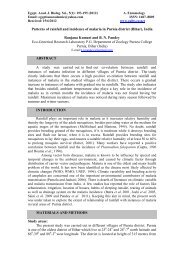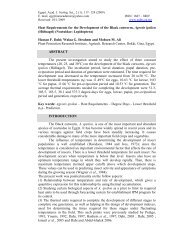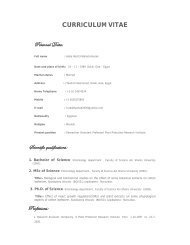Effect of Saccharicoccus sacchari (Cockerell) infestation levels on ...
Effect of Saccharicoccus sacchari (Cockerell) infestation levels on ...
Effect of Saccharicoccus sacchari (Cockerell) infestation levels on ...
You also want an ePaper? Increase the reach of your titles
YUMPU automatically turns print PDFs into web optimized ePapers that Google loves.
Egypt. Acad. J. biolog. Sci., 2 (2): 119-123 (2009) A. Entomology<br />
Email: egyptianacademic@yahoo.com ISSN: 1687-8809<br />
Received: 15/11/2009 www.eajbs.eg.net<br />
<str<strong>on</strong>g>Effect</str<strong>on</strong>g> <str<strong>on</strong>g>of</str<strong>on</strong>g> <str<strong>on</strong>g>Saccharicoccus</str<strong>on</strong>g> <str<strong>on</strong>g>sacchari</str<strong>on</strong>g> (<str<strong>on</strong>g>Cockerell</str<strong>on</strong>g>) <str<strong>on</strong>g>infestati<strong>on</strong></str<strong>on</strong>g> <str<strong>on</strong>g>levels</str<strong>on</strong>g><br />
<strong>on</strong> sugarcane physical and chemical properties<br />
Gamal El-Dein, H. Mohamed; Sanaa, A. M. Ibrahim and Fatma, A. Moharum<br />
Plant Protecti<strong>on</strong> Research Institute, Dokki, Giza 12618, Egypt.<br />
ABSTRACT<br />
The present investigati<strong>on</strong> was carried out in Sohage Governorate, Egypt <strong>on</strong><br />
sugarcane infested with <str<strong>on</strong>g>Saccharicoccus</str<strong>on</strong>g> <str<strong>on</strong>g>sacchari</str<strong>on</strong>g> (<str<strong>on</strong>g>Cockerell</str<strong>on</strong>g>) (Hemiptera:<br />
Pseudococcidae) during growing year 2007/2008. Obtained results indicated that <strong>on</strong>ly<br />
sever <str<strong>on</strong>g>infestati<strong>on</strong></str<strong>on</strong>g> significantly affected sugarcane physical and chemical properties.<br />
There were reducti<strong>on</strong> <str<strong>on</strong>g>of</str<strong>on</strong>g> stalk's weight (5.03, 34.33%), stalk's height (2.16, 6.93%),<br />
stalk internodes' number per stalk (8.8, 29.07) and juice weight (2.26, 31.62%) in low<br />
and heavy Infestati<strong>on</strong>, respectively compared with <str<strong>on</strong>g>infestati<strong>on</strong></str<strong>on</strong>g> free. Internodes height<br />
increased by 8.59 and 35.45% due to low and sever <str<strong>on</strong>g>levels</str<strong>on</strong>g> <str<strong>on</strong>g>of</str<strong>on</strong>g> <str<strong>on</strong>g>infestati<strong>on</strong></str<strong>on</strong>g>, respectively.<br />
There were losses <str<strong>on</strong>g>of</str<strong>on</strong>g> brix (4.95, 13.47%), sucrose (6.29, 27.87%), purity (1.41,<br />
16.87%), pol (5.29, 32.6%) and sugar recovery (5.29, 37.08%) and increase <str<strong>on</strong>g>of</str<strong>on</strong>g><br />
reducing sugar (3.53, 7.68%) and fiber (1.28, 3.85%) due low and heavy <str<strong>on</strong>g>levels</str<strong>on</strong>g> <str<strong>on</strong>g>of</str<strong>on</strong>g><br />
<str<strong>on</strong>g>infestati<strong>on</strong></str<strong>on</strong>g>, respectively.<br />
Key Words: <str<strong>on</strong>g>Saccharicoccus</str<strong>on</strong>g> <str<strong>on</strong>g>sacchari</str<strong>on</strong>g>, level <str<strong>on</strong>g>of</str<strong>on</strong>g> <str<strong>on</strong>g>infestati<strong>on</strong></str<strong>on</strong>g>, physical and chemical properties <str<strong>on</strong>g>of</str<strong>on</strong>g><br />
sugarcane<br />
INRODUCTION<br />
Sugarcane Saccharum <str<strong>on</strong>g>of</str<strong>on</strong>g>ficinarum L. is c<strong>on</strong>sidered the main materials for<br />
sugar processing (Darwish, 1979). The sugarcane plantati<strong>on</strong> area in Egypt reached<br />
about 350,000 feddans, producing 16 milli<strong>on</strong> t<strong>on</strong>s <str<strong>on</strong>g>of</str<strong>on</strong>g> sugarcane in 2007 (An<strong>on</strong>ymous,<br />
2008). Sugarcane in Egypt is subject o seven major pests and 24 other minor pests.<br />
The major pests are the pyrallid Chilo agamemn<strong>on</strong>, the noctuid Sesamia cretica, the<br />
coccid Pulvinaria tenuivalvata, three scrarabids and the pseudococcid <str<strong>on</strong>g>Saccharicoccus</str<strong>on</strong>g><br />
<str<strong>on</strong>g>sacchari</str<strong>on</strong>g> (<str<strong>on</strong>g>Cockerell</str<strong>on</strong>g>) (Hemiptera : Pseudococcidae)) (Abd-Rabou and Parker, 2008).<br />
The damage caused by the mealy bug S. <str<strong>on</strong>g>sacchari</str<strong>on</strong>g> occurs partly by sucking the<br />
plant sap and so leading to a group <str<strong>on</strong>g>of</str<strong>on</strong>g> thinner and stunted canes. The most serious<br />
loss, however, occurs from the industrial point <str<strong>on</strong>g>of</str<strong>on</strong>g> view, as the h<strong>on</strong>ey dew excreted by<br />
the mealy bug <strong>on</strong> the can surface, together with the exudati<strong>on</strong> <str<strong>on</strong>g>of</str<strong>on</strong>g> gums from parts<br />
wounded by the piercing mouth parts <str<strong>on</strong>g>of</str<strong>on</strong>g> the insects seriously interfere with the row<br />
sugar juice leading to a depressi<strong>on</strong> in the amount <str<strong>on</strong>g>of</str<strong>on</strong>g> sugar crystallized during the<br />
manufacturing process (Willcocks, 1925).<br />
Atiqui and Murad (1992) assessed sucrose and sugar c<strong>on</strong>tent (brix, pol and<br />
purity) losses as 10.64, 16.44, 6.14 and 12.92 %, respectively as a result <str<strong>on</strong>g>of</str<strong>on</strong>g> S. <str<strong>on</strong>g>sacchari</str<strong>on</strong>g><br />
<str<strong>on</strong>g>infestati<strong>on</strong></str<strong>on</strong>g>. Yield damage caused to sugarcane by Pulvinaria iceryi (Signoret)<br />
(Hemiptera: Coccidae) and Aulacaspis tegalensis (Zhnt.) (Hemiptera: Diapspididae)<br />
are cane weight and sucrose c<strong>on</strong>tent losses (An<strong>on</strong>ymous, 1987). Saleh (2005)<br />
reported significant relati<strong>on</strong>ship between five <str<strong>on</strong>g>levels</str<strong>on</strong>g> <str<strong>on</strong>g>infestati<strong>on</strong></str<strong>on</strong>g> <str<strong>on</strong>g>of</str<strong>on</strong>g> effect Pulvinaria<br />
tenuivalvata (Newstead) (Hemiptera: Coccidae) <strong>on</strong> the yield and quality some<br />
characters <str<strong>on</strong>g>of</str<strong>on</strong>g> sugarcane. Goel et al., (1983) indicated that heavily <str<strong>on</strong>g>infestati<strong>on</strong></str<strong>on</strong>g> by<br />
Melanaspis glomerata (Green) (Hemiptera: Diapspididae) <strong>on</strong> cane cased cane weight,
Gamal El-Dein, H. Mohamed et al.<br />
juice brix, sucrose c<strong>on</strong>tent <str<strong>on</strong>g>of</str<strong>on</strong>g> the juice and purity losses <str<strong>on</strong>g>of</str<strong>on</strong>g> 51.61, 27.69, 39.0 and<br />
13.39 %, respectively.<br />
This work aimed to evaluate damage cased by low and sever <str<strong>on</strong>g>levels</str<strong>on</strong>g> <str<strong>on</strong>g>of</str<strong>on</strong>g><br />
<str<strong>on</strong>g>infestati<strong>on</strong></str<strong>on</strong>g> <str<strong>on</strong>g>of</str<strong>on</strong>g> S. <str<strong>on</strong>g>sacchari</str<strong>on</strong>g> <strong>on</strong> sugarcane quantitative and qualitative characters and<br />
juice producti<strong>on</strong>.<br />
MATERIAL AND METHODS<br />
The present investigati<strong>on</strong> was carried out at Gerga, Sohage Governorate,<br />
Egypt during a single growing year 2007/2008 (i.e. from Apr. 2007 to Apr. 2008).<br />
The design <str<strong>on</strong>g>of</str<strong>on</strong>g> experiments was as follows:<br />
An area <str<strong>on</strong>g>of</str<strong>on</strong>g> about half feddan (i.e. 2000 m 2 ) was divided into three parts<br />
according to level <str<strong>on</strong>g>of</str<strong>on</strong>g> <str<strong>on</strong>g>infestati<strong>on</strong></str<strong>on</strong>g> as low, sever and free <str<strong>on</strong>g>of</str<strong>on</strong>g> <str<strong>on</strong>g>infestati<strong>on</strong></str<strong>on</strong>g>. Identificati<strong>on</strong> <str<strong>on</strong>g>of</str<strong>on</strong>g><br />
S. <str<strong>on</strong>g>sacchari</str<strong>on</strong>g> was carried out by first and third author, using the insect cutes collecti<strong>on</strong><br />
list.<br />
Asample <str<strong>on</strong>g>of</str<strong>on</strong>g> 25 internodes were chosen at random from each divisi<strong>on</strong> under<br />
investigati<strong>on</strong> and replicated 3 times. The samples were examinati<strong>on</strong>, using a<br />
magnifying glass at m<strong>on</strong>thly basis. Alive stages found <strong>on</strong> each sample were recorded<br />
as: pre-adult and females.<br />
Assessment <str<strong>on</strong>g>of</str<strong>on</strong>g> certain physical properties <str<strong>on</strong>g>of</str<strong>on</strong>g> sugarcane variety C.9/54, was<br />
carried out at harvesting time (i.e. 12 Apr. 2008). A sample <str<strong>on</strong>g>of</str<strong>on</strong>g> 10 stalks (replicate 3<br />
times) representing each divisi<strong>on</strong> was taken as random to determine the following<br />
parameters: stalk weight (g.), stalk height (m), high <str<strong>on</strong>g>of</str<strong>on</strong>g> internodes (cm), internodes<br />
number <str<strong>on</strong>g>of</str<strong>on</strong>g> stalk and juice weight (g).<br />
Chemical analysis <str<strong>on</strong>g>of</str<strong>on</strong>g> sugarcane juice produced (after <strong>on</strong>e hour from<br />
harvesting) from these stalks was c<strong>on</strong>ducted. One and half liter juice <str<strong>on</strong>g>of</str<strong>on</strong>g> them was<br />
taken in glass cylinder for calculating the characters according to the formula<br />
described by methods <str<strong>on</strong>g>of</str<strong>on</strong>g> Sugar and Integrated Industries Company (S.I.I.C.) (Mathur,<br />
1981) to determine the following parameters:<br />
*Brix percent (the percent <str<strong>on</strong>g>of</str<strong>on</strong>g> total soluble solids in 100 ml <str<strong>on</strong>g>of</str<strong>on</strong>g> juice) was measured by<br />
brix hydrometer standardized at 20 ºC in the laboratory.<br />
*Sucrose percent which was determined by using Saccarometer according to<br />
A.O.A.C. (An<strong>on</strong>ymous, 1995).<br />
*Purity percent was calculated according to the following equati<strong>on</strong>,<br />
Purity % = (Sucrose % / brix %) ×100.<br />
*Pol.= ( Sucrose %) × Pol factor.<br />
* Fiber %, and Reducing sugar percent were determined according to the method<br />
described in (Mathur, 1981).<br />
*Sugar recovery percent was calculated according to the following equati<strong>on</strong>, Sugar<br />
recovery % = Richness % × Purity %.<br />
-Richness = (Sucrose in100mg × factor) /100.<br />
-Factor = 100- (fiber % + physical impurities % + percent water free from sugar).<br />
Statistical analysis as analysis <str<strong>on</strong>g>of</str<strong>on</strong>g> variance was c<strong>on</strong>ducted to clarify the<br />
significance between obtained <str<strong>on</strong>g>levels</str<strong>on</strong>g> <str<strong>on</strong>g>of</str<strong>on</strong>g> damage.<br />
RESULTS AND DISCUSSION<br />
Data in Table (1) show m<strong>on</strong>thly mean counts <str<strong>on</strong>g>of</str<strong>on</strong>g> S. <str<strong>on</strong>g>sacchari</str<strong>on</strong>g> recorded <strong>on</strong> each<br />
m<strong>on</strong>thly count as pre-adults and females. Counts mean were 73.5 & 19.1 for low
<str<strong>on</strong>g>Effect</str<strong>on</strong>g> <str<strong>on</strong>g>of</str<strong>on</strong>g> S. <str<strong>on</strong>g>sacchari</str<strong>on</strong>g> <str<strong>on</strong>g>infestati<strong>on</strong></str<strong>on</strong>g> <str<strong>on</strong>g>levels</str<strong>on</strong>g> <strong>on</strong> sugarcane physical and chemical properties<br />
<str<strong>on</strong>g>infestati<strong>on</strong></str<strong>on</strong>g> and 757.5 & 256.6 for sever <str<strong>on</strong>g>infestati<strong>on</strong></str<strong>on</strong>g>. The data indicated low <str<strong>on</strong>g>infestati<strong>on</strong></str<strong>on</strong>g><br />
harbored about 10 % <str<strong>on</strong>g>of</str<strong>on</strong>g> the sever <strong>on</strong>e.<br />
Table (1): M<strong>on</strong>thly mean number <str<strong>on</strong>g>of</str<strong>on</strong>g> S. <str<strong>on</strong>g>sacchari</str<strong>on</strong>g> recorded <strong>on</strong> 25 internodes <str<strong>on</strong>g>of</str<strong>on</strong>g> infested sugarcane.<br />
Low <str<strong>on</strong>g>infestati<strong>on</strong></str<strong>on</strong>g> Sever <str<strong>on</strong>g>infestati<strong>on</strong></str<strong>on</strong>g><br />
Date<br />
Pre-adults<br />
Adult<br />
females<br />
Total Pre-adults<br />
Adult<br />
females<br />
Total<br />
Apr. 2007 49.3 7.6 57 483.6 91 534.8<br />
May 2007 112.4 19.3 155.7 1298.1 277.1 1575.3<br />
Jun. 2007 87.2 6.8 94 854.9 81.1 936<br />
Jul. 2007 47.2 8.1 55.3 462.9 96.5 559.4<br />
Aug. 2007 83.4 37.1 140.6 916.1 561 1477.1<br />
Sept. 2007 209.4 68.7 292.1 2092.4 936.9 3029.3<br />
Oct. 2007 132.9 51.5 188.4 1303.1 660.8 1963.9<br />
Nov. 2007 67.6 14.4 92 760.6 171.9 932.5<br />
Dec. 2007 47.8 5.7 53.6 468.9 68.4 537.3<br />
Jan. 2008 8.6 1.5 11.1 94.4 17.6 112<br />
Feb. 2008 14.1 2.1 16.2 138.6 24.8 163.4<br />
Mar. 2008 22.1 6.7 29.8 216.4 91.9 308.3<br />
Total 882 229.5 1185.8 9090 3078.9 12129<br />
Mean 73.5 19.1 98.8 757.5 256.6 1010.8<br />
Results for cane physical properties are presented in Table (2). Results show<br />
that weight <str<strong>on</strong>g>of</str<strong>on</strong>g> stalk was decreased by 5.03 % in the low <str<strong>on</strong>g>infestati<strong>on</strong></str<strong>on</strong>g> and 34.33 % <str<strong>on</strong>g>of</str<strong>on</strong>g><br />
sever <str<strong>on</strong>g>infestati<strong>on</strong></str<strong>on</strong>g> compared with free <str<strong>on</strong>g>of</str<strong>on</strong>g> <str<strong>on</strong>g>infestati<strong>on</strong></str<strong>on</strong>g>. This reducti<strong>on</strong> was <strong>on</strong> significance<br />
between low and free <str<strong>on</strong>g>of</str<strong>on</strong>g> <str<strong>on</strong>g>infestati<strong>on</strong></str<strong>on</strong>g>. For height <str<strong>on</strong>g>of</str<strong>on</strong>g> stalks there was no significance<br />
between different tested <str<strong>on</strong>g>levels</str<strong>on</strong>g> <str<strong>on</strong>g>of</str<strong>on</strong>g> <str<strong>on</strong>g>infestati<strong>on</strong></str<strong>on</strong>g>. Internodes' height increased by 8.59 and<br />
35.45% due to low and sever <str<strong>on</strong>g>infestati<strong>on</strong></str<strong>on</strong>g>, respectively. This increase was not<br />
significance between low and <str<strong>on</strong>g>infestati<strong>on</strong></str<strong>on</strong>g> free. The number <str<strong>on</strong>g>of</str<strong>on</strong>g> internodes/stalk was<br />
reduced at sever <str<strong>on</strong>g>infestati<strong>on</strong></str<strong>on</strong>g> by 29.07 % while at low <str<strong>on</strong>g>infestati<strong>on</strong></str<strong>on</strong>g> it was 8.80 %. This<br />
reducti<strong>on</strong> was not clearly significance between different <str<strong>on</strong>g>levels</str<strong>on</strong>g> <str<strong>on</strong>g>of</str<strong>on</strong>g> <str<strong>on</strong>g>infestati<strong>on</strong></str<strong>on</strong>g>. Juice<br />
weight showed reducti<strong>on</strong> <str<strong>on</strong>g>of</str<strong>on</strong>g> 2.26 and 31.62 % for low and sever <str<strong>on</strong>g>infestati<strong>on</strong></str<strong>on</strong>g>. This<br />
indicated significance differences between sever <str<strong>on</strong>g>infestati<strong>on</strong></str<strong>on</strong>g> and others.<br />
Table (2): <str<strong>on</strong>g>Effect</str<strong>on</strong>g> <str<strong>on</strong>g>of</str<strong>on</strong>g> <str<strong>on</strong>g>levels</str<strong>on</strong>g> <str<strong>on</strong>g>of</str<strong>on</strong>g> <str<strong>on</strong>g>infestati<strong>on</strong></str<strong>on</strong>g> with S. <str<strong>on</strong>g>sacchari</str<strong>on</strong>g> <strong>on</strong> physical properties <str<strong>on</strong>g>of</str<strong>on</strong>g> sugarcane at<br />
harvesting time (12 Apr. 2008).<br />
Infestati<strong>on</strong> level<br />
Free <str<strong>on</strong>g>of</str<strong>on</strong>g><br />
<str<strong>on</strong>g>infestati<strong>on</strong></str<strong>on</strong>g><br />
Stalk<br />
weight (g.)<br />
Height <str<strong>on</strong>g>of</str<strong>on</strong>g><br />
stalk (m.)<br />
High <str<strong>on</strong>g>of</str<strong>on</strong>g><br />
internodes<br />
(cm.)<br />
No.<br />
internodes/stalk<br />
Juice<br />
weight<br />
(g.)<br />
935 a 2.31 a 20.69 a 21.6 a 587 a<br />
Low <str<strong>on</strong>g>infestati<strong>on</strong></str<strong>on</strong>g> 888 a 2.26 a 22.47 a 19.70 a 574 a<br />
Sever <str<strong>on</strong>g>infestati<strong>on</strong></str<strong>on</strong>g> 614 b 2.15 a 28.03 b 15.32 ab 402 b<br />
L.S.D 63.75 0.4 5.54 3.46 148.81<br />
Results for extracted cane juice properties are presented in Table (3). Results<br />
showed the effect <str<strong>on</strong>g>of</str<strong>on</strong>g> <str<strong>on</strong>g>infestati<strong>on</strong></str<strong>on</strong>g> <strong>on</strong> percentages <str<strong>on</strong>g>of</str<strong>on</strong>g> brix which was reduced by 4.95 and<br />
13.47 % <str<strong>on</strong>g>of</str<strong>on</strong>g> low and sever <str<strong>on</strong>g>infestati<strong>on</strong></str<strong>on</strong>g>, respectively with <strong>on</strong> significance between tested<br />
<str<strong>on</strong>g>levels</str<strong>on</strong>g> <str<strong>on</strong>g>of</str<strong>on</strong>g> <str<strong>on</strong>g>infestati<strong>on</strong></str<strong>on</strong>g>. Similar was sucrose percent which was reduced at by 6.29 and<br />
27.87 % for low and sever <str<strong>on</strong>g>infestati<strong>on</strong></str<strong>on</strong>g> with <strong>on</strong> significance between tested <str<strong>on</strong>g>levels</str<strong>on</strong>g>.<br />
Percent <str<strong>on</strong>g>of</str<strong>on</strong>g> purity was reduced by 1.41 % at low <str<strong>on</strong>g>infestati<strong>on</strong></str<strong>on</strong>g> level. This reducti<strong>on</strong> was<br />
not significant from free if <str<strong>on</strong>g>infestati<strong>on</strong></str<strong>on</strong>g>. Sever <str<strong>on</strong>g>infestati<strong>on</strong></str<strong>on</strong>g> resulted in significant<br />
reducti<strong>on</strong> <str<strong>on</strong>g>of</str<strong>on</strong>g> 16.87 % compared with others. Reducing sugar increased insignificantly<br />
as <str<strong>on</strong>g>infestati<strong>on</strong></str<strong>on</strong>g> level increased as 3.53 % and 35.45 %, respectively. Percent <str<strong>on</strong>g>of</str<strong>on</strong>g> fiber
Gamal El-Dein, H. Mohamed et al.<br />
also was not affected by differences between the level <str<strong>on</strong>g>of</str<strong>on</strong>g> <str<strong>on</strong>g>infestati<strong>on</strong></str<strong>on</strong>g>. The pol value<br />
was reduced significantly as result <str<strong>on</strong>g>of</str<strong>on</strong>g> sever <str<strong>on</strong>g>infestati<strong>on</strong></str<strong>on</strong>g> compared with other <str<strong>on</strong>g>levels</str<strong>on</strong>g>. It<br />
was 32.62 and 5.29 % for sever and low <str<strong>on</strong>g>infestati<strong>on</strong></str<strong>on</strong>g> <str<strong>on</strong>g>levels</str<strong>on</strong>g> respectively. Sugar<br />
recovery was not significantly reduced by low <str<strong>on</strong>g>of</str<strong>on</strong>g> <str<strong>on</strong>g>infestati<strong>on</strong></str<strong>on</strong>g> (i.e. 5.29 %) while it was<br />
reduced significantly by sever <str<strong>on</strong>g>infestati<strong>on</strong></str<strong>on</strong>g> (i.e. 37.08 %).<br />
Table (3): <str<strong>on</strong>g>Effect</str<strong>on</strong>g> <str<strong>on</strong>g>of</str<strong>on</strong>g> <str<strong>on</strong>g>levels</str<strong>on</strong>g> <str<strong>on</strong>g>of</str<strong>on</strong>g> <str<strong>on</strong>g>infestati<strong>on</strong></str<strong>on</strong>g> with S. <str<strong>on</strong>g>sacchari</str<strong>on</strong>g> <strong>on</strong> certain chemical properties <str<strong>on</strong>g>of</str<strong>on</strong>g> sugar can<br />
juice at harvesting time (12 Apr.2008).<br />
Infestati<strong>on</strong> level Brix Sucrose % Purity % Reducing Sugar % Fiber % Pol Sugar recovery%<br />
Free <str<strong>on</strong>g>of</str<strong>on</strong>g> <str<strong>on</strong>g>infestati<strong>on</strong></str<strong>on</strong>g> 18.78 a 15.75 a 83.86 a 5.67 a 12.48 a 13.98 a 13.98 a<br />
Low <str<strong>on</strong>g>infestati<strong>on</strong></str<strong>on</strong>g> 17.85 a 14.76 a 82.68 a 5.87 a 12.64 a 13.24 a 13.24 a<br />
Sever <str<strong>on</strong>g>infestati<strong>on</strong></str<strong>on</strong>g> 16.25 a 11.36 a 69.71 b 7.68 a 12.96 a 9.42 b 7.74 b<br />
L.S.D 5.65 4.8 4.98 2.77 0.59 3.2 4.06<br />
Generally the obtained results indicated that low level <str<strong>on</strong>g>of</str<strong>on</strong>g> <str<strong>on</strong>g>infestati<strong>on</strong></str<strong>on</strong>g> did not<br />
significantly affected sugarcane physical and chemical properties while sever <strong>on</strong>e did.<br />
These results are in agreement with Atiqui and Murad (1992) who assessed the<br />
loss <str<strong>on</strong>g>of</str<strong>on</strong>g> sucrose c<strong>on</strong>tent <str<strong>on</strong>g>of</str<strong>on</strong>g> sugarcane <str<strong>on</strong>g>infestati<strong>on</strong></str<strong>on</strong>g> by S. <str<strong>on</strong>g>sacchari</str<strong>on</strong>g> as decreased <str<strong>on</strong>g>of</str<strong>on</strong>g> sucrose<br />
and sugar c<strong>on</strong>tent <str<strong>on</strong>g>of</str<strong>on</strong>g> the cane and its purity (with average losses in sugar brix, pol,<br />
purity and available sugar c<strong>on</strong>tent were 10.64, 16.44, 6.14 and 12.92 %, respectively).<br />
Goel et al. (1983) indicated that in heavily <str<strong>on</strong>g>infestati<strong>on</strong></str<strong>on</strong>g> by M. glomerata <strong>on</strong> cane were<br />
the cane weight, juice brix, sucrose c<strong>on</strong>tent <str<strong>on</strong>g>of</str<strong>on</strong>g> the juice and purity were reduced by<br />
51.61, 27.69, 39.0 and 13.39 %, respectively. An<strong>on</strong>ymous (1987) menti<strong>on</strong>ed to yield<br />
losses caused to sugarcane by P. iceryi and damage level <str<strong>on</strong>g>of</str<strong>on</strong>g> the 2 comp<strong>on</strong>ents <str<strong>on</strong>g>of</str<strong>on</strong>g> loss,<br />
cane weight and sucrose c<strong>on</strong>tent. Besheit et al. (2002) studied the effect <str<strong>on</strong>g>of</str<strong>on</strong>g> P.<br />
tenuivalvata <strong>on</strong> the yield and quality <str<strong>on</strong>g>of</str<strong>on</strong>g> sugarcane. The data indicated that under<br />
heavy <str<strong>on</strong>g>infestati<strong>on</strong></str<strong>on</strong>g> reducti<strong>on</strong> percent recorded 51.24, 32.96, 46.08, 61.51, 73.24 and<br />
31.24 for average stalk weight, juice extracti<strong>on</strong> percentage, brix, (% Richness), %<br />
sugar extracted (rendment) and purity. Shalaby (2002) found there was significant<br />
reducti<strong>on</strong> in weight <str<strong>on</strong>g>of</str<strong>on</strong>g> cane to 22.9 % infested cane by P. tenuivalvata and reducti<strong>on</strong><br />
in juice extracti<strong>on</strong> and percent sucrose averaged 28.62 % and 4.13 %, respectively.<br />
Saleh (2005) reported that there were significant differences between <str<strong>on</strong>g>infestati<strong>on</strong></str<strong>on</strong>g><br />
<str<strong>on</strong>g>levels</str<strong>on</strong>g> by P. tenuivalvata and stalk weight, stalk height, stalk <str<strong>on</strong>g>of</str<strong>on</strong>g> internodes number<br />
and juice weight. Percent <str<strong>on</strong>g>of</str<strong>on</strong>g> brix, purity, sucrose, purity, richness and sugar recovery<br />
were decreased by increasing the percent <str<strong>on</strong>g>of</str<strong>on</strong>g> <str<strong>on</strong>g>infestati<strong>on</strong></str<strong>on</strong>g> by P. tenuivalvata.<br />
Further studies are required to determine the level <str<strong>on</strong>g>of</str<strong>on</strong>g> <str<strong>on</strong>g>infestati<strong>on</strong></str<strong>on</strong>g> which require<br />
introducti<strong>on</strong> <str<strong>on</strong>g>of</str<strong>on</strong>g> c<strong>on</strong>trol measurements.<br />
REFERENCES<br />
Abd-Rabou, S. and B. Parker (2008). A review <str<strong>on</strong>g>of</str<strong>on</strong>g> sugarcane pests in Egypt. Egypt J.<br />
Agric. Res., 86 (1): 1- 42.<br />
An<strong>on</strong>ymous (1987). A report from Mauritius Sugar Institute.<br />
An<strong>on</strong>ymous (1995). Official methods <str<strong>on</strong>g>of</str<strong>on</strong>g> analysis. Associati<strong>on</strong> <str<strong>on</strong>g>of</str<strong>on</strong>g> Official Agricultural<br />
Chemists (A.O.A.C.), Washingt<strong>on</strong> D.C., USA.<br />
An<strong>on</strong>ymous (2007). Agricultural statistics, winter crops. Ministry <str<strong>on</strong>g>of</str<strong>on</strong>g> Agriculture,<br />
Egypt, Vol. (1) Dec. 2008. 150 pp.
<str<strong>on</strong>g>Effect</str<strong>on</strong>g> <str<strong>on</strong>g>of</str<strong>on</strong>g> S. <str<strong>on</strong>g>sacchari</str<strong>on</strong>g> <str<strong>on</strong>g>infestati<strong>on</strong></str<strong>on</strong>g> <str<strong>on</strong>g>levels</str<strong>on</strong>g> <strong>on</strong> sugarcane physical and chemical properties<br />
Atiqui, M.U.A. and H. Murad (1992). Assessment <str<strong>on</strong>g>of</str<strong>on</strong>g> loss in sucrose c<strong>on</strong>tent <str<strong>on</strong>g>of</str<strong>on</strong>g><br />
sugarcane due to sugarcane mealy bug, <str<strong>on</strong>g>Saccharicoccus</str<strong>on</strong>g> <str<strong>on</strong>g>sacchari</str<strong>on</strong>g> (Ckll). J.<br />
Insect Sci. 5 (2): 196 – 197.<br />
Besheit, S. Y.; A. A. Abaziad; A. M. El-Gomaa; A. S. Abo El-Hamd (2002). The<br />
influence <str<strong>on</strong>g>of</str<strong>on</strong>g> the <str<strong>on</strong>g>infestati<strong>on</strong></str<strong>on</strong>g> by the s<str<strong>on</strong>g>of</str<strong>on</strong>g>t scale insect Pulvinaria tenuivalvata<br />
(Newstead) Homoptera: Coccidae <strong>on</strong> sugarcane stalk weight, juice quality and<br />
sugar yield in Upper Egypt. Egypt, Assut J. <str<strong>on</strong>g>of</str<strong>on</strong>g> Agric. Sci. 33(4):17-28<br />
Darwish, Y. Y. I. (1979). Fertilizer requirements <str<strong>on</strong>g>of</str<strong>on</strong>g> sugarcane in Kom-Ombo. M. Sc.<br />
Thesis, Fac. Agic., Alexandria Univ. 119 pp.<br />
Goel, S. C.; T. A. V. S. Raghunath and S. C. Goel (1983). Losses due to scale insect<br />
in sugarcane variety CO. A 7602. Insect Ecology and Resource Management,<br />
1983:142-146.<br />
Mathur, R. B. L. (1981). Handbook <str<strong>on</strong>g>of</str<strong>on</strong>g> cane sugar technology. Sec<strong>on</strong>d revised and<br />
enlarged editi<strong>on</strong>. Oxford and IBH publishing Co. Pvt. Ltd., New Delhi and<br />
Calcuta.<br />
Shalaby, M. S. I. (2002). Ecological and biological studies <strong>on</strong> the sugarcane scale<br />
Pulvinaria tenuivalvata (Newstead) infesting sugarcane in Giza Governorate.<br />
Ph. D. Thesis, Fac. Agic., Al-Azhar Univ. 209 pp.<br />
Saleh, H. A. (2005). Impact <str<strong>on</strong>g>of</str<strong>on</strong>g> the red striped s<str<strong>on</strong>g>of</str<strong>on</strong>g>t scale insect, Pulvinaria tenuivalvata<br />
(Newstead) <str<strong>on</strong>g>infestati<strong>on</strong></str<strong>on</strong>g> <strong>on</strong> the quantity and quality plant <str<strong>on</strong>g>of</str<strong>on</strong>g> sugarcane under<br />
certain cultural practices Ph. D. Thesis, Fac. Agric. Cairo Univ. Egypt,<br />
143pp.<br />
Willcocks, F. C. (1925). The insect and related pests <str<strong>on</strong>g>of</str<strong>on</strong>g> Egypt II. Insects and mites<br />
feeding <strong>on</strong> graminous crops and products in the field, granary and mill.<br />
Sultanic Agric. Soc., II, Cairo.<br />
ARABIC SUMMARY<br />
ةيئاميكلا و ةيعيبطلا تافصلا ىلع ىقيقدلا بصقلا قب ةرشحب ةباصلإا نم ةفلتخم تايوتسم ريثأت<br />
ركسلا بصقل<br />
مرحم ميلحلا دبع ةمطاف - ميھاربأ دمحم -ر<br />
د اقلا دبع ءانس - دمحم نيسح نيدلا لامج<br />
. رصم - 12618 - ةزيجلا - ىقدلا - تاتابنلا ةياقو ثوحب دھعم<br />
نم ىقيقدلا بصقلا قب ةرشح ربتعتو ،ملاعلا ىف ةماھلا ةيداصتقلإا<br />
ليصاحملا نم ركسلا بصق دعي<br />
ىف ركسلا بصق لوصحم بيصت ىتلا ةريطخلا تافلآا نم ةحنجلأا ةيفصن ةبترل عباتلا بذاكلا ىقيقدلا قبلا ةلئاع<br />
. رصم<br />
نم نييوتسم ريثأت ةنراقم ضرغب ،2008/<br />
2007 ماع للاخ جاھوس ةظفاحم ىف ةساردلا تيرجأ<br />
كانھ ناكو . ركسلا بصق تابنل ةيعيبطلا تافصلا ىلع ةميلسلا تاتابنلاب ( هديدش ىرخأو هفيفخ هباصا)<br />
ةباصلإا<br />
،(%2.16,<br />
6.93) دوعلا لوط طسوتم ( % 34.33 ،5.03)<br />
دوعلا نزو طسوتم}<br />
نم لك ىف ةباصلأا ةجيتن صقن<br />
،(%2.26,<br />
31.62) تايملاسلا<br />
ددع طسوتم ىف صقن ، (%8.59, 35.45) ةيملاسلا لوط طسوتم ىف هدايز<br />
نم نييوتسملا ةجيتن ريصعلل ةيئايمكلا تايوتحملا رثأت ىدم كلذكو ، { (%2.26, 31.62) جتانلا ريصعلا نزو<br />
بصقلا ركسل ةيوئملا ةبسنلا ،(%4.95,<br />
13.47) سكربلا ) } ىف صقن كانھ ناكف باصملا ريغب ةنراقم ةباصلأا<br />
ىرظنلا جتانلا ، (%5.29, 32.6) ةلدعملا ةولاحلا ،(%1.41,<br />
16.87) ةلدعملا ةواقنلا ، (%6.29, 27.87)<br />
ىف تلازتخملل ةيوئملا ةبسنلا}<br />
ىف ةباصلأاةجيتن هدايز كانھ ناكو ،{<br />
(%5.29, 37.08) ركسلا نم<br />
ةدايزب صقن دجو ثيح ركسلا بصق ىف { (%1.28, 3.85) فايللأل ةيوئملا ةبسنلا ،(%3.53,<br />
7.68) ركسلا<br />
سكعب ايونعم هديدشلا هباصلاا ىوتسم ىلا عجارلا صقنلا ناك ةماع . ىقيقدلا بصقلا<br />
قب ةرشحب ةباصلإا ىوتسم<br />
.<br />
هفيفخلا هباصلاا
















